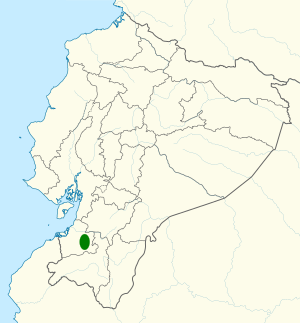Blue-throated hillstar facts for kids
Quick facts for kids Blue-throated hillstar |
|
|---|---|
 |
|
| Conservation status | |
| Scientific classification | |
| Genus: |
Oreotrochilus
|
| Species: |
cyanolaemus
|
 |
|
The blue-throated hillstar (Oreotrochilus cyanolaemus) is a special type of hummingbird. It lives only in a small part of the Andes mountains in southwestern Ecuador. Scientists first found this bird in 2017.
Contents
About its Name and Family
The name "cyanolaemus" comes from old Greek words. "Kuanos" means ultramarine blue, and "laimos" means throat. So, its name describes its bright blue throat!
Scientists have studied its DNA. They found that the blue-throated hillstar is closely related to other hillstar hummingbirds. These include the black-breasted hillstar and the green-headed hillstar.
What it Looks Like
The male blue-throated hillstar is very colorful. The top of its head is a shiny emerald green. This green color goes from its forehead to the back of its head. Its neck and back are also bright emerald green. Some feathers have blue-green edges or bronze highlights.
The most striking part is its throat and chin. These feathers are a sparkling ultramarine blue. This bright blue patch is why the bird got its name. It also has a velvety black band around its throat. Its belly and chest are a dull white with a black stripe down the middle. The sides of its body are green or greenish-gray. Its tail feathers are blackish-blue.
The female blue-throated hillstar also has an emerald green back. Her tail feathers are brighter and more blue than the male's. Her throat and chin are speckled with gray-olive and dark green spots. The sides of her throat are whiter. Her belly and chest are grayish-buff. Her tail has white patches that can be different sizes.
Both male and female blue-throated hillstars have black beaks. The male blue-throated hillstar is easy to spot. Look for its ultramarine blue throat and emerald green head. Females have a dusky-gray chin and a whitish lower throat.
This bird's calls sound like other hillstars. They make fast chirping sounds that go up and down. They also make single "up-down" calls.
Where it Lives and What it Eats
The blue-throated hillstar likes to live in grasslands. These grasslands have patches of shrubs in the Andean paramo (a type of high-altitude grassland). It lives in hilly areas with rocky spots and stream banks.
This hummingbird feeds by clinging to branches. It can even hang sideways or upside down! It also perches next to flowers to drink nectar. It mostly feeds from a plant called Chuquiraga jussieui. Sometimes, females have been seen catching flies in the air.
Other birds sometimes chase blue-throated hillstars away from their favorite spots. These include the Shining Sunbeam and the Viridian metaltail.
Protecting this Special Bird
This hummingbird lives in a very small area in Ecuador. This area is only about 114 square kilometers (44 square miles). Its home is surrounded by river valleys.
Sadly, there are not many blue-throated hillstars left. Scientists think there are fewer than 750 of them. This bird is in danger from fires, animals grazing, and gold mining.
Good news! Many groups are working to protect this bird. Nature and Culture International is working with Ecuador's government and local communities. They want to create a new protected area. This area would cover about 175,000 acres in Cerro de Arcos. It would protect the blue-throated hillstar's entire home. It would also save important páramo and cloud forest areas. These areas have wetlands and important water sources. The new area would also help protect parts of the ancient Inca trail.
See also
 In Spanish: Estrella de garganta azul para niños
In Spanish: Estrella de garganta azul para niños

